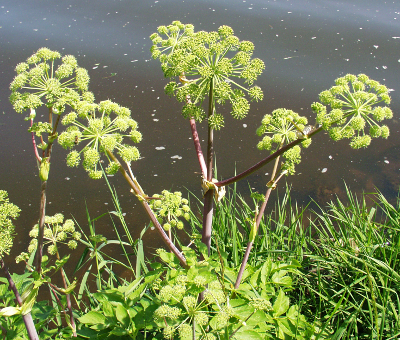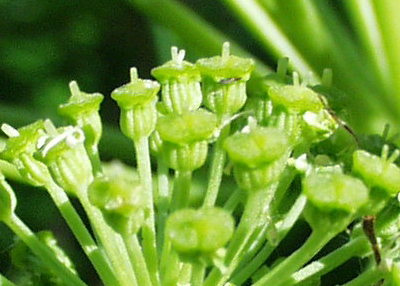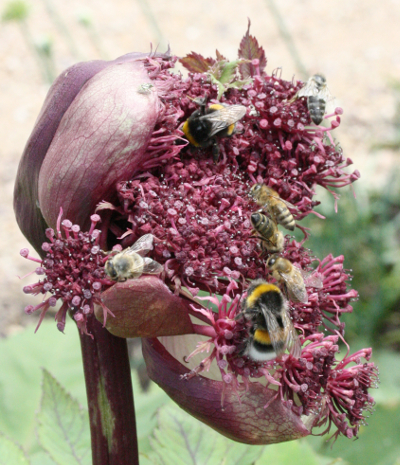Angelica |

Habit of the garden angelica (Angelica archangelica)

Fruits of the garden angelica

Opening inflorescence of the giant
angelica (Angelica gigas)
with bloom visitors. The country of origin is Korea
With the Vikings they came to Central Europe. The first written record of the scientific name comes from Leonhard Fuchs in his 1543 published book on herbs. Linnaeus in 1753 described four different species of Angelica in his Species Plantarum. The name correlate the plants with angels, which probably refers to their reputed healing powers.
About 100 species includes the genus that may be found with the greatest number of species in Eurasia and North Africa. It consist of bi- or perennial herbs, often with rhizomes or taproots. The stems are mostly upright, hollow and usually high and strong, glabrous or hairy, striped and branched in the upper part. The alternate, stalked, rather large leaves are pinnate or 2- to 3-fold pinnate. The petioles often surround the stems with widened leaf sheaths.
The inflorescences are double umbels and arranged terminally and laterally. Bracts of the umbel, the so-called involucre, are mostly missing or consist of only a few linear leaves. The 10 to multi-rayed umbel splits into spherical or hemispherical umbellules which carry white, yellowish, greenish or pink flowers. The involucel consist of mostly numerous bracts. The calyx teeth are missing, are very small or rarely well developed. The flowers are small, hermaphrodite and proterandrous. The apices of the petals are often bent inward.
After insect pollination develop ovate to roundish, laterally flattened fruits with 10 ribs, whereas the lateral four ones are often broad or winged. They are composed of 2 mericarps with a quite broad junction that respectively shows 5 ribs. Upon maturation, the fruits turn to yellow or brown.
| Floral formula: |
| * K5 C5 A5 G(2) inferior |
Historical publications
Since the genus occurs exclusively in northern Europe, the ancient authors as Theophrastus, Pliny or Dioscorides could not know it. Only in the 16th century the plants appear in books on herbs of Leonhard Fuchs, Tabernaemontanus, Matthiolus and Dodoens who deal in great detail with the plants. In addition to a variety of other applications, they recommended the angelica root, held in the mouth, as a prophylactic against the plague.
Meaning of the species names
- archangelica: gr. arkhangelos = archangel
- litoralis: lat. litoralis = belonging to the shore/beach
- sylvestris: lat. sylvestris = wild
Interesting notes
-
As the shape of the fruit suggests, Angelica is very closely related to the highly toxic Aethusa cynapium.
-
"Dong quai" or "female ginseng" the Chinese angelica (Angelica sinensis) is called, which is used in traditional oriental medicine to treat gynecological problems.